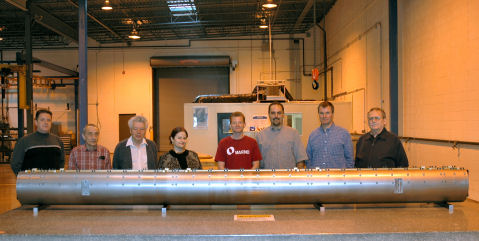 |
Linac Coherent Light Source |
External Pages
• Contacts
• LCLS at SLAC
Internal Pages
• Safety and QA
• Effort Reporting System
• Project Pages
• What's New
|
Welcome to the Linac Coherent Light Source (LCLS) website of Argonne National Laboratory. The LCLS will be the world's first x-ray free electron laser when it becomes operational in 2009. LCLS is currently in the construction phase. Pulses of x-ray laser light from LCLS will be many orders of magnitude brighter and several orders of magnitude shorter than what can be produced by any other x-ray source available now or in the near future. These characteristics will enable frontier new science in areas that include discovering and probing new states of matter, understanding and following chemical reactions and biological processes in real time, imaging chemical and structural properties of materials on the nanoscale, and imaging non-crystalline biological materials at atomic resolution.
The second industrially-assembled production undulator is shown at the occasion of its factory acceptance. Argonne team members and members of staff of Metalex Manufacturing are shown after acceptance. The undulator has been shipped to APS for magnetic measurement and tuning. The undulator is the magnetic device that forces the electrons to ocsillate violently back and forth and produce large amounts of x-rays. These x-rays interact back on the electrons and force them to bunch at x-ray wavelengths. When this happens the electrons emit their light "coherently" and a large gain in radiation power is experienced. This feedsbacks into the electron distribution causing even more intense x-rays. This process continues until it reaches saturation at which point the peak brightness of the x-rays are a billion times more than have even been produced before. This unprecedented brightness will enable revolutionay new science. We hope you find the information you need here. If not feel free to contact us and we will be happy to help you out in any way possible. |
|
||||
 The LCLS project is funded by the U.S. DOE and is a collaboration of three national laboratories and one university. Stanford Linear Accelerator Center (SLAC) in Menlo Park, CA. is the host laboratory for the LCLS. Argonne National Laboratory, with the expertise of the Advanced Photon Source, is the partner laboratory responsible for the delivery of the roughly 130-m long undulator system.
The LCLS project is funded by the U.S. DOE and is a collaboration of three national laboratories and one university. Stanford Linear Accelerator Center (SLAC) in Menlo Park, CA. is the host laboratory for the LCLS. Argonne National Laboratory, with the expertise of the Advanced Photon Source, is the partner laboratory responsible for the delivery of the roughly 130-m long undulator system.